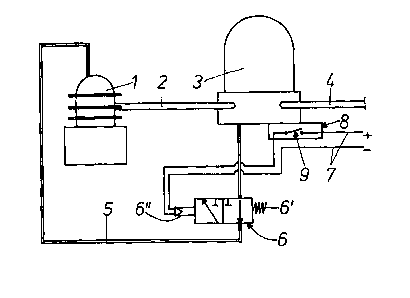Some of the information on this Web page has been provided by external sources. The Government of Canada is not responsible for the accuracy, reliability or currency of the information supplied by external sources. Users wishing to rely upon this information should consult directly with the source of the information. Content provided by external sources is not subject to official languages, privacy and accessibility requirements.
Any discrepancies in the text and image of the Claims and Abstract are due to differing posting times. Text of the Claims and Abstract are posted:
| (12) Patent Application: | (11) CA 2293809 |
|---|---|
| (54) English Title: | AN AIR DRIER ARRANGEMENT |
| (54) French Title: | ARRANGEMENT DE DESSICCATEUR D'AIR |
| Status: | Deemed Abandoned and Beyond the Period of Reinstatement - Pending Response to Notice of Disregarded Communication |
| (51) International Patent Classification (IPC): |
|
|---|---|
| (72) Inventors : |
|
| (73) Owners : |
|
| (71) Applicants : |
|
| (74) Agent: | SMART & BIGGAR LP |
| (74) Associate agent: | |
| (45) Issued: | |
| (86) PCT Filing Date: | 1998-06-17 |
| (87) Open to Public Inspection: | 1998-12-23 |
| Examination requested: | 2003-02-28 |
| Availability of licence: | N/A |
| Dedicated to the Public: | N/A |
| (25) Language of filing: | English |
| Patent Cooperation Treaty (PCT): | Yes |
|---|---|
| (86) PCT Filing Number: | PCT/SE1998/001170 |
| (87) International Publication Number: | WO 1998057730 |
| (85) National Entry: | 1999-12-09 |
| (30) Application Priority Data: | ||||||
|---|---|---|---|---|---|---|
|
An air drier arrangement comprises an air compressor (1), an air drier (3) and
air conduits (2, 4). In order to obtain favourable working conditions for the
arrangement under different temperatures there is a switch-over valve (6) in a
separate signal air pipe (5) from the air drier to the compressor. This valve
is operable between a first position, giving a governor mode for the
arrangement, and a second position, giving an unloader mode for the
arrangement. The operation of the valve may be governed by a thermostat (9).
Un arrangement de dessiccateur d'air comprend un compresseur (1) d'air, un dessiccateur (3) d'air et des conduits (2, 4) d'air. Afin d'obtenir des conditions de fonctionnement favorables à l'arrangement à différentes températures, on a disposé une valve de commutation (6) dans un conduit (5) d'air à signal séparé du dessiccateur d'air au compresseur. Cette valve fonctionne dans une première position, donnant un mode régulateur à l'arrangement, et dans une seconde position donnant un mode de décharge à l'arrangement. Le fonctionnement de la valve peut être régulé par un thermostat (9).
Note: Claims are shown in the official language in which they were submitted.
Note: Descriptions are shown in the official language in which they were submitted.

2024-08-01:As part of the Next Generation Patents (NGP) transition, the Canadian Patents Database (CPD) now contains a more detailed Event History, which replicates the Event Log of our new back-office solution.
Please note that "Inactive:" events refers to events no longer in use in our new back-office solution.
For a clearer understanding of the status of the application/patent presented on this page, the site Disclaimer , as well as the definitions for Patent , Event History , Maintenance Fee and Payment History should be consulted.
| Description | Date |
|---|---|
| Application Not Reinstated by Deadline | 2006-05-17 |
| Inactive: Dead - No reply to s.30(2) Rules requisition | 2006-05-17 |
| Deemed Abandoned - Failure to Respond to Maintenance Fee Notice | 2005-06-17 |
| Inactive: Abandoned - No reply to s.30(2) Rules requisition | 2005-05-17 |
| Inactive: Abandoned - No reply to s.29 Rules requisition | 2005-05-17 |
| Inactive: S.29 Rules - Examiner requisition | 2004-11-17 |
| Inactive: S.30(2) Rules - Examiner requisition | 2004-11-17 |
| Letter Sent | 2003-04-02 |
| All Requirements for Examination Determined Compliant | 2003-02-28 |
| Request for Examination Received | 2003-02-28 |
| Request for Examination Requirements Determined Compliant | 2003-02-28 |
| Letter Sent | 2000-03-01 |
| Inactive: Cover page published | 2000-02-17 |
| Inactive: First IPC assigned | 2000-02-16 |
| Inactive: Courtesy letter - Evidence | 2000-02-01 |
| Inactive: Single transfer | 2000-01-28 |
| Inactive: Notice - National entry - No RFE | 2000-01-26 |
| Application Received - PCT | 2000-01-25 |
| Application Published (Open to Public Inspection) | 1998-12-23 |
| Abandonment Date | Reason | Reinstatement Date |
|---|---|---|
| 2005-06-17 |
The last payment was received on 2004-06-01
Note : If the full payment has not been received on or before the date indicated, a further fee may be required which may be one of the following
Please refer to the CIPO Patent Fees web page to see all current fee amounts.
| Fee Type | Anniversary Year | Due Date | Paid Date |
|---|---|---|---|
| Basic national fee - standard | 1999-12-09 | ||
| Registration of a document | 2000-01-28 | ||
| MF (application, 2nd anniv.) - standard | 02 | 2000-06-19 | 2000-05-29 |
| MF (application, 3rd anniv.) - standard | 03 | 2001-06-18 | 2001-05-29 |
| MF (application, 4th anniv.) - standard | 04 | 2002-06-17 | 2002-05-24 |
| Request for examination - standard | 2003-02-28 | ||
| MF (application, 5th anniv.) - standard | 05 | 2003-06-17 | 2003-05-28 |
| MF (application, 6th anniv.) - standard | 06 | 2004-06-17 | 2004-06-01 |
Note: Records showing the ownership history in alphabetical order.
| Current Owners on Record |
|---|
| HALDEX BRAKE PRODUCTS AB |
| Past Owners on Record |
|---|
| SVEN-OLOF LARSSON |